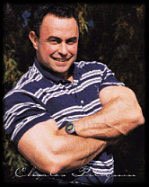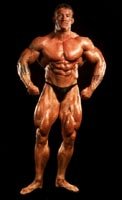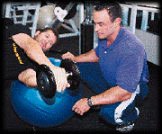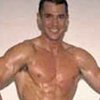It was time to get behind the art and the science of training so I went out researching. One of the few strength and bodybuilding coaches that I identified with in theories was Mr. Poliquin. He was focused on functional training methods for some of the best Olympic athletes, but he knew quite a bit about muscle hypertrophy (muscle growth). With the track record he possessed and the philosophies he lived by Charles became the natural choice of strength and weight lifting guru for myself and thousands of others.
Zach Marcy: Charles, just so our readers get the nitty gritty on you, can you give us a basic background?
Charles Poliquin: I first got involved in strength training through martial arts. At age 14, I became the second-youngest karate student in Canada ever to achieve a black belt. It was my karate sensei who first introduced me to weight training. One day I came to the dojo and I was the only one who showed because of raging blizzard. My sensei Web Corcoran couldn't see teaching karate to a class of one, so we spent the time lifting weights."
 I never stopped lifting weights, and my career unfolded quite naturally from that point. I received my Bachelors degree in kinesiology and began coaching athletes before returning to further studies to earn an Masters in exercise physiology. Early in my studies I realized that the majority of research in exercise physiology concentrated on aerobic exercise. In order to find research on strength training, I had to turn to European journals, particularly those from Germany. So I set about teaching myself German to complement the French and English in which I was already fluent.
I never stopped lifting weights, and my career unfolded quite naturally from that point. I received my Bachelors degree in kinesiology and began coaching athletes before returning to further studies to earn an Masters in exercise physiology. Early in my studies I realized that the majority of research in exercise physiology concentrated on aerobic exercise. In order to find research on strength training, I had to turn to European journals, particularly those from Germany. So I set about teaching myself German to complement the French and English in which I was already fluent.
Today I am better known for his achievements with Olympic and professional athletes. He has coached athletes in 23 Olympic sports and from 9 different countries. He is presently coaching mainly N.H.L. and N.F.L. players. I have written over 600 articles on strength coaching for numerous lay and peer-review publications, and his work has been translated into English, Swedish, German, French, Italian, Dutch, Slovakian, and Japanese.
Zach Marcy: Your clients have an amazing track record of success. Here is a brag segment of the interview. Who have you trained and what are some of the amazing accomplishments that some of these athletes have achieved?
Charles Poliquin: Some of the athletes I have coached include:
- Myriam Bédard, 3 times Olympic medallist and world champion in biathlon
- Marc Gagnon, world champion and Olympic medallist in short-track speed skating
- Natalie Lambert, world champion and Olympic medallist in short-track speed skating
- Pierre Lueders, Olympic Gold Medallist in 2-man Bobsleigh.
- Al MacInnis, St. Louis Blues, Norris Trophy winner, strongest slap-shot in the NHL, Olympic Goal Medallist
- Edgar Martinez of the Seattle Mariners, one of the most successful hitters in major league baseball.
- Nanceen Perry, world record holder, 4x200 meters, Olympic bronze medallist in 4 x 100 meters in Sydney Olympics.
- Sandie Richards , Olympic bronze medallist in 4 x 400 meters in Sydney Olympics.
- Chris Pronger, St. Louis Blues, winner of Norris and Hart trophies, Olympic Goal Medallist
- David Boston, Arizona Cardinals, Wide Receiver and Pro Bowl athlete
Zach Marcy: How did you first get into training some of the worlds elite athletes? Were you destined to do this or did it happen across your path and you jumped on it?
Charles Poliquin: It started with a National Team Volleyball player who saw me training in the weight room at the university and asked for my help. Under my guidance, he tested a few months as the most powerful player on the team, which lead me to train one of his colleagues, who brought me another one. The rest is history.
Zach Marcy: Your not one of the pencil necked trainers that you see in the gym. You have some SERIOUS guns and appear to practice what you preach. I'm currently on Phase 3 of your arm program laid out in Winning The Arms Race and I love the intensity and set layout of the program. Can you explain some of the principles of this program and some of the results you've seen from it?
Charles Poliquin: Basically Winning The Arms Race is a compilation of the best arm routines I know. It should give you 6 months of continuous growth.
Zach Marcy: One of the philosophies that you teach, and I've successfully adapted in my own trainings, is that of constant, dynamic change in your programs. You've said there is no ONE program that will work forever, but continuous change in your programs keeps people making constant gains. Can you expound on this?
Charles Poliquin: Getting stronger or bigger is like learning a foreign language. If you don't challenge your "learning", you will never grow.
Zach Marcy: Another philosophy I've heard you talk about is interspersing strength cycles in with hypertrophy cycles of weight lifting. In other words there are times someone interested in bodybuilding should stray from doing exercises for muscle size only and should focus more on strength. What are the theories behind this and why would it benefit a bodybuilder to train in this manner?
Charles Poliquin: A bodybuilder aims at hypertrophying the cross-section of their muscles. Strength training allows them to recruit new motor units that they can hypertrophy with their regular training.
Zach Marcy: You say there is no perfect training system, but people should rotate through various training methods in order to be in a state of constant growth. Say I'm a bodybuilder looking to place together 3 or 4 programs that I can rotate through in order to get my best results of hypertrophy. In your opinion, what 3 or 4 best workout programs could I do the rest of my life in order to stay in a constant growth state?
Charles Poliquin: It would not work optimally. Sixteen different good programs would give you more gains than 4 good programs rotated in and out.
Zach Marcy: In recent days I've been involved in numerous debates on a lot of your methods vs. the methods of HIT promoted by the late Mike Mentzer. What arguments can you make for your basic methods versus some of the other philosophies in HIT?
 Charles Poliquin: Dorian Yates has been and is still under the care of my clinic as often as we can meet. We have had the chance to exchange concepts in training. One cannot argue with his results, but he realizes that varying the exercises more would have given him a healthier longer career. But exercise tolerance is a very unique thing as discussed in the book I co-authored with Will Brink Muscle Building Nutrition (it is available on Charles's web site) HIT does work, but I don't think it is for every body. For example, Brian Haycock system also works. I trained that way in University and made zero progress. I am blessed with a high percentage of fast-twitch fibers, therefore I need more sets of low reps to progress.
Charles Poliquin: Dorian Yates has been and is still under the care of my clinic as often as we can meet. We have had the chance to exchange concepts in training. One cannot argue with his results, but he realizes that varying the exercises more would have given him a healthier longer career. But exercise tolerance is a very unique thing as discussed in the book I co-authored with Will Brink Muscle Building Nutrition (it is available on Charles's web site) HIT does work, but I don't think it is for every body. For example, Brian Haycock system also works. I trained that way in University and made zero progress. I am blessed with a high percentage of fast-twitch fibers, therefore I need more sets of low reps to progress.
Zach Marcy: There are so many arguments on when to take post workout meals and shakes. Where do you stand on this and how can one limit the cortisol while promoting muscle recovery?
Charles Poliquin: I have a strong advocate of post-workout liquid nutrition since 1982 with great success. Post-workout liquid was the brain child of doctors working with the former East Germany rowing teams. Originally, it was only maltodextrine solutions designed to meet the high caloric needs of rowers. The knowledge was eventually passed down to other national teams like biathlon and cycling.
Over the years I have worked at improving the formula. Here is the latest recommendations based on my observations and a host of scientific research, on the actual make-up of the drink. These recommendations are for one hour workouts (excluding warm-up time to first work set).
Protein intake: Should be 0.6 g/kg of lean body mass. So if the athlete is 90 kg at 10% body fat, that would represent 50 grams of protein.
Carbohydrate intake: Originally based on the research that was available at the time, I typically recommended 2 g/Kg of bodyweight. Over the years, after being exposed to more research and discussing it with my colleagues, I have come to the conclusion that it should be a reflection of the training volume for the training session. The greater the number of reps per training unit, the greater the carbohydrate intake. Of course, one can not assume that all reps are equal. A squatting or deadlifting rep is more demanding than a curling or triceps extension rep. By the same token, 3 reps slow tempo squats has different caloric demand than 3 reps in the power clean. As a general rule, I would recommend the following carbohydrate intake based on training volume for a given workout:
-
12-72 reps per workout: 0.6 g/Kg/LBM
73-200 reps per workout: 0.8 g/kg/LBM
200-360 reps per workout: 1.0 g/kg/LBM
360-450 reps per workout: 1.2 g/kg/LBM
Calculate Your LBM
Regarding the source of carbohydrates post-workout, I have experimented with various sources, I like using fruit juices with a high glycemic index (i.e. pineapple, grape) to provide 30-40% of the carbs, the rest of the carbs coming from carb powders such as Ultra Fuel from Twinlab.
For variety sake, I will use different types of juice like a berry blend. You can also any type of mushy fruit like bananas or peaches. For seriously underweight athletes, I may use pineapple and/or corn flakes to drive the glycemic index upwards. Instead of using maltodextrin, you can also use desiccated honey.
 Glutamine intake: Recent scientific research has demonstrated that consuming glutamine following exercise can accelerate muscle glycogen resynthesis and glutamine levels, which are critical in the prevention of overtraining, and the creation of an anabolic environment. I recommend ingesting 0.33 g/kg of glutamine, so for a 90 kg man that would be 30 grams. If someone has a higher percentage bodyfat, I up the glutamine and reduce the carbs,
Glutamine intake: Recent scientific research has demonstrated that consuming glutamine following exercise can accelerate muscle glycogen resynthesis and glutamine levels, which are critical in the prevention of overtraining, and the creation of an anabolic environment. I recommend ingesting 0.33 g/kg of glutamine, so for a 90 kg man that would be 30 grams. If someone has a higher percentage bodyfat, I up the glutamine and reduce the carbs,
Arginine intake: Arginine greatly aids in storing more glycogen. Usually 3 grams should do the trick
For More Info
It doesn't get much better than this, guys. If you want the secrets of the most elite Olympic and professional athletes in the world, here it is.
For those of you guys impressed with what you have read in this interview I would highly recommend going over to http://www.charlespoliquin.net and at least purchasing Winning The Arms Race. Mr. Poliquin has several free articles and information on the site.
Thanks,
